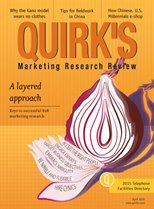Editor’s note: Chris Donaldson is creative director at U.K.-based health care consulting firm Kantar Health.
Dear PowerPoint,
We need to talk. We’ve been together for about 15 years now and I just feel like … well I just feel like it’s time to move on. I think we both know in our heart of hearts that we’re just going through the motions now and while I’m literally still pushing your buttons, metaphorically you’re no longer pushing mine.
Things have become comfortable between us and comfortable is not a great place to be in a relationship. Relationships have to continue to grow and blossom throughout life. There can be no standing still.
I remember when I first set eyes on you in 1997. I was going through a messy separation from some transparent acetates and an overhead projector and there you were sitting on my desk, fresh and dynamic. I just looked at you and embraced you. Was it love at first sight? I don’t know, I don’t think anyone really understands that sort of thing. But how I felt then is very different from how I feel now.
PowerPoint, what makes this so hard is that we’ve been through so much together and have had some amazing times. Remember how good we were together in 2003 at the “Obesity market understanding” presentation? Or how about during the “Cardiovascular campaign development” in 2008? So many good times … far too many to mention.
Your attempts in 2007 and again in 2010 to put the spark back in our relationship with your “enhancements” were appreciated and the chemistry did return a little but we were only delaying the inevitable.
I don’t have anyone else in my life at the moment but as much as this hurts me I have to say it: I want to see other presentation software. I need to be stimulated again, to be spontaneous, to have fun … to be able to express myself fully. This is so difficult to write because I still feel close to you and I really want us to remain friends.
You’re welcome to stay with me for the time being but we will need to formally separate at some stage in the near future.
Yours,
Chris
I’m sure everyone in market research – whether working in industry or agency – involved in presenting study findings over the last five years or so has wished to part ways with PowerPoint. Maybe not in such a semi-romantic way as above but they’ve given it thought. However, I’d argue that people are being far too hasty to dismiss this omnipresent part of business life.
Let’s return to reality. PowerPoint is a piece of software – a good piece of software that has been given a hard time in recent years. The real problem is in the way people (mis)use PowerPoint, with the result being poor presentations.
There’s a fundamental fact about presentations that we sometimes lose sight of, and that is in any presentation, the role of software such as PowerPoint is purely one of visual support to the presenter. However, sometimes what’s written on the slides almost mirrors what is coming out of the presenter’s mouth, so people are effectively reading content like a document or, as presentation design guru Garr Reynolds calls it, a “slide-u-ment.” Script and document often equal lots of words and numbers, which equal poor impact and clarity, which in turn result in poor delivery and thus a poor presentation. We shouldn’t be blaming PowerPoint for this.
The result of this somewhat misguided attack on PowerPoint has turned a steady-paced exploration of PowerPoint alternatives into some sort of quest for the Holy Grail, with alternatives such as Prezi taking on the role of the cup from which Jesus drank (or possibly presented with). Agencies and researchers have been so desperate to get on the bandwagon of PowerPoint alternatives, to be seen as innovative and to show that they’re moving on from PowerPoint, that they’ve missed the point of where we’re going wrong. Prezi is now perceived as a fad (or a one-night stand if you want to continue the relationship theme), something that became instantly popular simply because it wasn’t PowerPoint. It’s a shame, really. Prezi still has a role to play in the right situation; however, it should never have been seen as interchangeable with PowerPoint.
We can’t continue this obsession with finding alternatives to PowerPoint and we can’t continue to blame it for our bad presentations. Instead we need to look at the way we engage with and use PowerPoint and start a different kind of relationship – a relationship where the presenter, not the presentation software, is the star.
